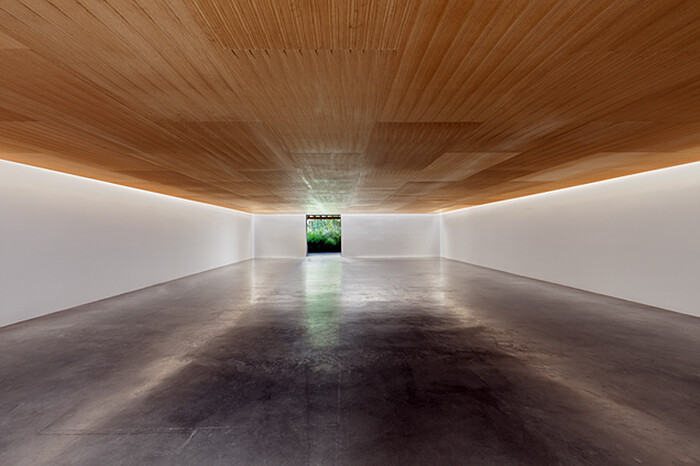November 19, 2010–January 29, 2011
When viewing Compass, I had an uncanny feeling of being lost. Part of this had to do with the theatrical power of the work, yet a sense of dread came over me as I realized that this was actually a restaging. Although it is great to revisit a work, this new context leads to some measure of troubling questions. Namely, in this re-presentation, the artists had swapped out the video that was paired with the work the first time—and, in so doing, provided a problematic relation. This change makes a world of conceptual difference when considering the artists’ oeuvre and their practice, which is charted toward Venice to represent the USA for the next Biennale, but also makes an accidental commentary on the art industry as a whole.
When entering Compass, the viewer is presented with a vast empty space that has been bisected by a dropped ceiling, dividing the gallery into two levels—a narrow skylight allows light to filter from the top a la Louis Kahn and Tadao Ando. Other than the light, the lower level is entirely empty, save for a similar bleed in sound seeping in from above. What we’re hearing is the scuffling of dancers who take turns performing six “mapped” solo maneuvers. The resultant program produces a seaside calm analogous to the subdued serenity of a modern spa, noble and relaxed. A screening room visible at the far end of the main room is where one finds the ersatz video piece, A Man Screaming Is Not a Dancing Bear (2008). Here, one sees a man strumming a tune on a set of venetian blinds hung in a house flooded in the Katrina disaster, crosscut with tracking shoots of a swamp. With this work as well, there is a play of sight and sound as light flickers in and out of the manipulated blinds producing an effect like an Aldis lamp, a metaphoric SOS perhaps? With such close proximity and its resultant pairs of rhyming devices, the experience of the two works collapse together. Groping for meaning, the titling of both works makes me ask: is the dancer also a person in anguish seeking safe harbor? The trouble in this reading is that the dancers are not really victims at all, but quite simply performers. Looking for a guide, something, anything to help me navigate the possible meanings, I turned to the gallery’s didactics and a catalog to find that both pieces were not designed together, but are, as I said, a restaging of sorts.
Compass was first presented in the Temporäre Kunsthalle Berlin in 2009 and designed specifically for that large expansive space. Aiding this apparent “site-specificity,” the installation was paired with a video, How to Appear Invisible (2009). This track features the demolition of the Palast der Republik (the seat of the parliament of the GDR), which stood next to Temporäre Kunsthalle. With this juxtaposition, various allusions to the end of an oppressive regime and its manifest symbolism weigh down on the viewer like the floating ceiling—which, in my opinion, would be better served by dropping the ceiling further, as the room is simply too comfortable. Also, the title puns the dancers’ paths with the compass found on the GDR flag, and may point to a need to measure this society and its aftermath. But what does this say when the work is restaged in Mexico and paired with a piece about the Katrina disaster?
By swapping one video for another, the work now tracks a course of opportunism, as the architectural intervention and its adaptation to like spaces appears to overtake any clear reflection on these momentous and very different histories. While the work is very impressive on physical grounds, the re-pairing of it here comes off as glib and overly generalized. Sadly, this rhetoric could have been eschewed so that the work could revel in its own theatrical wonder by simply cutting the weak narrative and social platitudes, or conversely by not changing the video in the first place.
I realized that this game of mix and match points to a reality that the objecthood of the artwork and its symbols now only becomes a kind of platform for readymade intellectual ponderings. However, the joke is on us if we favor “discourse” as a justification for enjoying that which is right in front of our eyes: a wonderful architectural detail. That is to say, there is always a “man” behind the curtain; however, it is useful to ask, what the curtain is. In this case, it’s not the ceiling, which hides the dancer; it’s the press releases, catalogs, and other like devices, which cloak the work.







